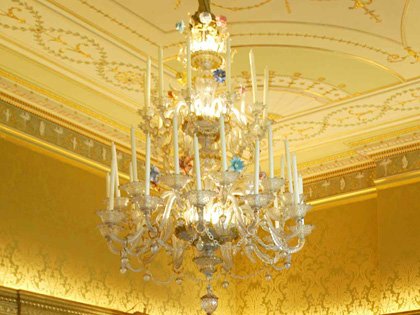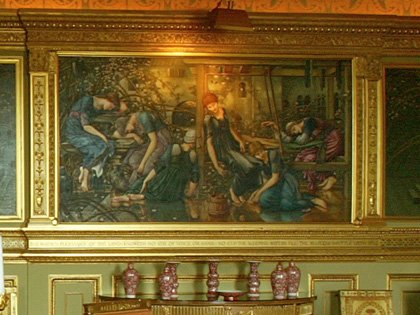The Saloon
This room, and the next along the north front of the house, the Drawing Room, retains its original late eighteenth-century plasterwork ceilings. The identity of the plasterers, who worked for Loveden at Buscot in the 1780s, is unfortunately not known, though the designs are close in style to some of the later work of Joseph Rose the Younger.
Both the delicate neo-classical plasterwork of the Saloon’s ceiling and frieze and the fine mahogany doors survive from Loveden’s original room, while the rest of the decorative scheme, including the gold silk wall-hangings, is contemporary with the celebrated Burne-Jones paintings depicting the Legend of the Briar Rose.
In 1871, Burne-Jones began painting a series illustrating the story of the Sleeping Beauty. The four large pictures that composed the final version, the fruit of twenty years work, were eventually exhibited in 1890 at Agnew’s Gallery, Old Bond Street, and all London flocked to see them. Hailed as ‘the most remarkable [work] of modern English art’, they toured to Liverpool and Manchester before becoming the centrepiece of the annual Whitechapel art exhibition in the East End, where they brought joy to thousands of ordinary working Londoners.
The pictures had always been intended for use as decorations, and the 1st Lord Faringdon (then Mr Alexander Henderson) acquired them for the Drawing Room at Buscot. When Burne-Jones visited the house soon afterwards (he was staying at the time with William Morris at Kelmscott, across the fields from Buscot) their setting did not satisfy him. He therefore designed a framework of carved and gilt wood which would give unity to the four pictures – The Briar Wood, The Council Room, The Garden Court, and The Rose Bower (nos.35–38). For the intervening spaces he painted narrow panels that continue the rose motif.
The restoration and refurbishment of the room was carried out for Lord Faringdon and his trustees in 1995 by Alidad, to mark the centenary of the National Trust’s foundation.
Furniture
The set of giltwood chairs and the settee, all in their original silk upholstery, are Empire and bear the stamp of the ébéniste Pierre-Antoine Bellangé (1757–1827). They are very similar to a suite supplied by Bellangé to the White House in 1817, by order of President James Monroe.
The pair of semi-circular side-tables, with parcel-gilt legs and frieze, and with satinwood tops finely inlaid with floral designs, are reputed to be the gift of George III, who stayed at Buscot after an illness, and are among the few pieces of furniture in the house to survive from Loveden’s day. They may well be the work of Charles Elliott, and were probably conceived as a set of four, a similar pair having been at Mereworth Castle, in Kent, until they were sold in 1968.
The two small inlaid commodes, either side of the chimney-piece, are French, nineteenth century, in the Louis XV style. The two marquetry commodes with Brescia marble tops, one at each end of the room, are North Italian, probably designed by Giuseppe Levati and executed in the manner of Maggiolini.
The fine Regency library table in the centre of the room, of faded mahogany with bronzed enrichments, ebony and brass inlay in the French taste, is probably the work of John McLean and was supplied to Barnsley Park during John Nash’s remodelling of the library in c.1806-9.
The giant candelabra between the windows, each composed of two bronze female figures holding a vase with a spray of ormolu flowers (the upper flowers forming greasepans) are French, and belong to a set of four acquired by the 2nd Duke of Wellington in 1863 for Apsley House, London.
The Venetian glass chandelier, an exceptionally large and fine example, is probably by Salviati of Murano. The late-nineteenth century carpet is by Ziegler.
Ceramics
The Saloon contains some interesting porcelain. By the desk is a late nineteenth-century famille verte fish bowl on a giltwood stand. On the Italian commode stand two square Arita bottles of c.1700, and an unusual large Arita bottle of about 1675, the globular body enamelled with birds, flowers and brocade patterns in Holland in the early eighteenth century. The base bears the initials ‘I.C.’, in underglaze blue, probably for Johannes Camphuys, a Dutch merchant who, as principal in Deshima in 1671, 1673 and 1675, was entitled to have porcelain made to his private order and bearing his cipher.
The first of the semi-circular side-tables carries a garniture of Chinese turquoise monochrome ware, and the second a garniture of five Kangxi (1662–1722) and two later vases, with floral patterns on rouge de fer ground, and a dish with similar pattern bearing the seal mark of Jiaqing (1796–1820). Beneath the side-table stands a pair of famille rose barrel-shaped garden seats. On the second Italian commode, beside the chimney-piece, are five white dishes, the middle one of the Song period (760–1280), and a pair of the Song Qingbai period. The ormolu and white marble mantel-clock is by Martinot of Paris. The overmantel carries two bottles, two vases and a bowl, all of the eighteenth and nineteenth centuries. On the small Louis XV commodes are a Yuan bowl and a Chinese eighteenth-century vase with mottled decoration in imitation of shagreen.
On the library table in the centre are a pair of dark blue Qianlong glass vases with narrow necks, and a yellow and black ice pail of Paris manufacture (1790). Also on this table, the marble clock, by Festeau le Jeune, and the two vases, forming a garniture de cheminée, are of French mid-eighteenth-century design.








 = House & Grounds Open
= House & Grounds Open = Grounds Open Only
= Grounds Open Only = Closed
= Closed

 >
>